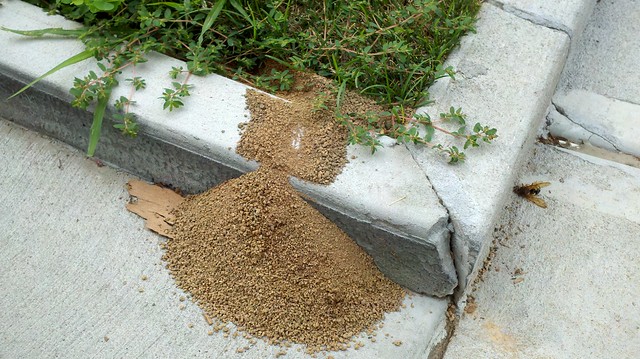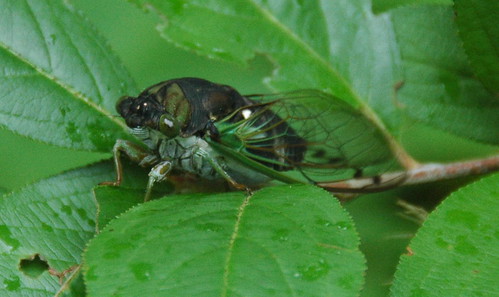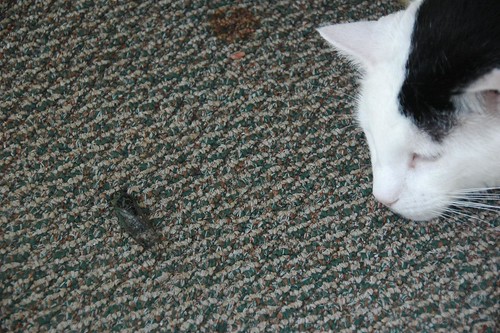Although I’ve lived in Brooklyn since 1992, I didn’t encounter Sphecius speciosus, the Eastern Cicada Killer, until we moved to Flatbush in 2005. It was summer, and I was working outside in the garden. Suddenly, here was the biggest wasp I had ever seen, large and loud, buzzing around my driveway and digging into the lawn next to it. I freaked out. I hosed out the burrow and destroyed the nest.
I regret having done that. I attribute my over-reaction partially to the stresses of being a first-time homeowner. I now find them beautiful. I consider myself lucky that we live in an urban area where these specialists can thrive. Besides, they are much too busy during their short adult lives to bother with people.
Sphecius speciosus, Eastern Cicada Killer, with prey, just inside the Eastern Parkway entrance of the Osborne Garden at Brooklyn Botanic Garden, August 2009
They have a fascinating, if gruesome by human standards, life history. It could easily be the inspiration for the xenomorph of the Alien movie series.
After mating, the female digs out a deep tunnel leading to a multi-chambered nest. They’re impressive excavators. This debris pile appeared overnight alongside our driveway and sidewalk in August of 2012. The concrete curb is 3″ high.
Here’s the entrance to a nest in Cattus Island Park in Toms River, in the coastal pine barrens of New Jersey, in August of 2011. Note there are 4 different colors of sand, showing the different layers, and depths, the female reached.
The female then hunts for and captures an adult cicada, paralyzing it with its sting without killing it. It returns with the cicada to its burrow, dragging it into one of the chambers of the nest. It lays a single egg on the cicada. It repeats this process several times. The female dies soon after egg-laying.
Sphecius speciosus, Eastern Cicada Killer, with prey, at the Flatbush CommUNITY Garden, July 2008
When the egg hatches, the larva feeds on the still-living cicada. When the cicada hs been completely consumed, the larva spins a cocoon and overwinters as a pre-pupa. In Spring it emerges from the cocoon as a pupa, eventually metamorphosizing and emerging as adults, male and female, for mating and renewing the cycle.
Dog-day Cicada (annual Cicada) in Prospect Park, July 2008
Cicada killers are solitary wasps. Males emerge from pupal cases in mid-July to early August, a few weeks before the females. The males tunnel out of the ground, leaving telltale holes, and select a territory that they actively defend. Females mate soon after emerging, and then begin digging burrows in the ground using their mandibles and legs. The burrows can be several feet deep with numerous branches.
Once construction is complete, the female searches in trees and shrubs. Upon capturing a cicada, the female stings it injecting venom. Then, she carries the cicada back to the burrow, where she lays an egg on its living, but paralyzed body. Within two weeks, the egg hatches into a larva, eats the cicada, and develops into a pre-pupa, the stage at which it will spend the winter. Cicada killers are active in late summer, the same time that cicadas are present. By September, most adults have died.
Although visually alarming, these wasps pose little threat. Females are not aggressive and rarely sting, unless excessively provoked. Males often display territorial behavior and will dive-bomb people’s heads; however, they have no sting and pose no real threat.
– Cicada Killer, Master Beekeeper Program, Cornell University
Felis catus ssp. cicadakilleratus ‘Ripley’ on my back porch, August 2009
I was prompted to write this in response to a message sent out on the Flatbush Family Network:
We seem to have an underground yellow jacket nest on our front walkway with a “Queen” that is about 2.5 inches long…..a little frightening to me but will absolutely scare the wits out of my kids- she looks like she can carry her own luggage! Anyone know an exterminator that can come and get rid of this Quick!?
Thanks, Lori
[bit.ly]
Related Content
Dog-Day Cicadas, 2008-07-11
Flickr photo set
Links
University of Kentucky Entomology
Ohio State University Extension

We have them here, too, and they are fascinating. I have some male cicada killers guarding the area next to the driveway this summer, making going out to get the mail or newspaper quite an adventure. I can see where they've dug their holes.
And my sister was stung by one once. It got up under her skirt and got confused. She said it hurt, yes indeed.
Great info!
Thanks, Carol! The males are territorial, but they don't sting. Only the females sting, and burrow. And yeah, I don't want to be stung by one!
I wonder what it is about driveways? I know they want sandy soil for digging. Maybe that's where they're most likely to find it in our yards.
I'm so glad I ran across your post! Our dog found one last week and was trying to eat it (he's only 1). I put the dog inside and tried to get the bog out of my yard so the dog wouldn't mess with it. I got it over the fence, but the cicada killer kept climbing into the yard. Finally, I just let the dog be. He forgot about the bug and everyone was happy. I was a bit freaked out about the wasp-on-steroids.
I saw a wasp like this and totally freaked out too. It wasn't in my garden or I probably would've gone all Rambo on it with the hose too.
It was beautiful and scary too. I think the most frighting part was the territorial behavior and the way they just seem to linger out in the open instead of flying off like other bees and wasps.
Nice post.
Do you know the extent of these wasps? They are really impressive.
By "extent" do you mean their native range? I don't know off-hand. I would check the Links provided at the end of the post.
These things took over our yard when we first moved here. It was a complete infestation. It was like a carpet of ginormous bees out back instead of a grassy lawn. There were so many they flew into our basement through the semi open windows and banged against our wooden basement door. I had a newborn and looked them up on the internet and learned they would go away after a few weeks. They tore up our yard, it was as if we had moles. The next spring we dug up the dirt, put down new dirt and re-seeded. My husband is diligent with the sprinkler and he tries really hard to keep a thick turf (to deter them). Seems like as long as the grass is happy and the soil is not dry, they don't burrow, even though I can see the holes where they emerge from the few nests we didn't manage to prevent from the year before. They definitely dive bomb you and let me tell you, toddlers do not like it. My husband has beaten them off with a tennis racket (they tend not to return after this). This summer was manageable, a few here and there, like accessories, but not the only story going on in our backyard.
It's been a while since I've visited your corner of Bklyn Xris. Love this post…so many people don't take into consideration that the 'bugs' they're afraid of are actually part of the machine. Thanks I'm linking it up.